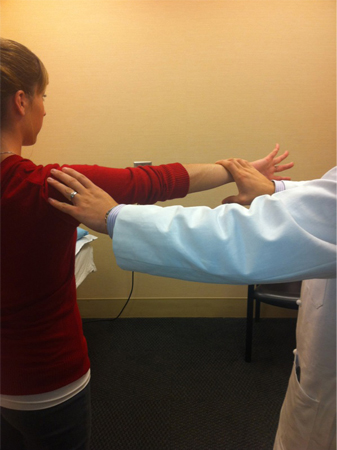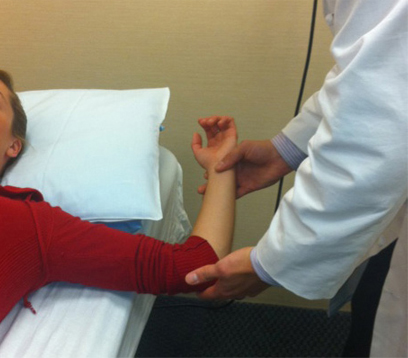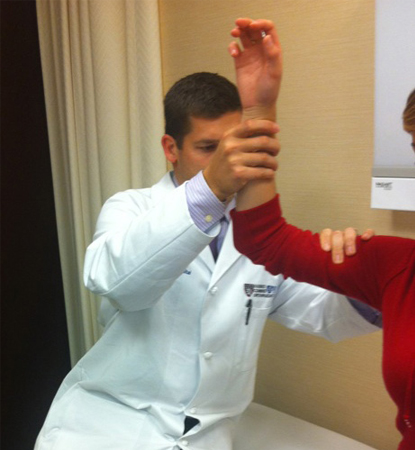History and exam
Key diagnostic factors
common
shoulder stiffness
Patients often report an inability to perform their jobs, overhead activities, or activities of daily living such as combing their hair or dressing/undressing.
decreased shoulder active range of motion
Accurate measurement of active glenohumeral range of motion is essential. Patients show marked decrease in active range of motion. Ensure that any active range of motion occurs at the glenohumeral joint, not via scapulothoracic motion. The patient should be examined supine, which locks the scapula between the chest wall and the examination couch.
decreased shoulder passive range of motion
A limited passive range of motion is a true indicator of severe loss of range of motion due to the inflammatory and fibrotic processes, whereas a limited active range of motion can simply indicate limitation due to pain.
positive coracoid pain test
The coracoid pain test is a highly sensitive and specific clinical exam finding for adhesive capsulitis. Pain elicited by direct pressure on the coracoid was 96% sensitive and 87% to 89% specific in one study describing the test.[29]
positive shoulder shrug test
The shoulder shrug test is a highly sensitive, but not specific, clinical exam finding for adhesive capsulitis. Inability to abduct the arm to 90º in the plane of the body and to hold that position briefly is considered positive. The test is 95% sensitive and 50% specific for adhesive capsulitis.[30]
Other diagnostic factors
common
shoulder pain
Many patients experience shoulder pain, but shoulder pain is not an essential component of adhesive capsulitis.
alternative diagnosis not suggested by provocative maneuvers
Provocative examination maneuvers for labral and rotator cuff pathology, as well as cervical spine pathology, can be used to exclude other potential causes for decreased shoulder range of motion.
negative Spurling maneuver (to exclude cervical spine radiculopathy)
One hand is placed on top of the patient's head while stabilizing the shoulders. The neck is hyperextended and the head gently tilted toward the symptomatic site.[Figure caption and citation for the preceding image starts]: Spurling maneuverFrom the private collection of Matthew T. Provencher, MD, CDR MC USN and Lance E. LeClere, MD, LCDR MC USN; used with permission [Citation ends].
Pain with this maneuver may indicate cervical spine radiculopathy.
negative Hawkins test (to exclude rotator cuff impingement)
The patient is seated with the shoulder in 90° of forward flexion and neutral adduction/abduction. The elbow is flexed to 90° and the examiner supports the arm as the shoulder is brought into internal rotation.
Pain with this maneuver indicates possible rotator cuff impingement.
negative Neer test (to exclude shoulder impingement)
The examiner maximally forward flexes the shoulder with the patient's elbow in full extension and the shoulder in maximal internal rotation.
Pain indicates shoulder impingement, especially with the arm in internal rotation versus external rotation.
negative Speed test (to exclude superior labrum from anterior to posterior [SLAP] tear)
With the elbow in full extension, the shoulder is forward flexed against resistance. The forearm should be in full supination.
Pain with this maneuver may indicate a SLAP tear.
negative O'Brien test (to exclude superior labrum from anterior to posterior [SLAP] lesion)
The patient's shoulder is forward flexed to 90° and adducted to 45°. The shoulder is then maximally internally rotated with the elbow in full extension. The patient is asked to elevate the arm as the examiner provides downward resistance, and with the thumb/palm in a downward position.[Figure caption and citation for the preceding image starts]: O'Brien testFrom the private collection of Matthew T. Provencher, MD, CDR MC USN and Lance E. LeClere, MD, LCDR MC USN; used with permission [Citation ends].
If the thumb down/palm down position elicits more pain than with upward palm, this indicates a potential SLAP lesion.
negative Yergason test (to exclude proximal biceps tendon pathology)
With the patient's arm at the side and elbow flexed to 90°, the examiner resists supination of the patient's forearm.[Figure caption and citation for the preceding image starts]: Yergason testFrom the private collection of Matthew T. Provencher, MD, CDR MC USN and Lance E. LeClere, MD, LCDR MC USN; used with permission [Citation ends].
Pain with the maneuver may indicate proximal biceps tendon pathology.
negative apprehension test (to exclude anterior shoulder instability)
The patient lies supine on the examination table. The arm is abducted to 90° and externally rotated.[Figure caption and citation for the preceding image starts]: Apprehension testFrom the private collection of Matthew T. Provencher, MD, CDR MC USN and Lance E. LeClere, MD, LCDR MC USN; used with permission [Citation ends].
A feeling of apprehension due to a subjective sensation of instability by the patient signifies a positive test. Pain alone is not a positive test.
negative relocation test (to further exclude anterior shoulder instability)
If the patient has a positive apprehension test, the examiner places a posteriorly directed force on the humeral head.
If the sensation of apprehension is relieved, this is a positive test and further supports the diagnosis of anterior instability.
negative Kim test (to exclude posteroinferior labral lesion of the shoulder)
The patient is seated with the arm in 90° of abduction. The arm is passively elevated to 100°-125° of forward flexion, and the examiner applies an axial load to the elbow while a posteroinferior force is applied to the upper arm.[Figure caption and citation for the preceding image starts]: Kim testFrom the private collection of Matthew T. Provencher, MD, CDR MC USN and Lance E. LeClere, MD, LCDR MC USN; used with permission [Citation ends].
Pain and posterior subluxation signify a positive test.
Risk factors
strong
age 40 to 70 years
Occurs most commonly in people between 40 and 70 years of age; however, can present at any age.[1]
diabetes mellitus
prior history of adhesive capsulitis
A prior history is a major risk factor for subsequent return of the disease in the contralateral shoulder. Twenty to thirty percent of women with existing adhesive capsulitis will be affected in the contralateral shoulder.[8]
shoulder pain and immobilization
previous shoulder surgery
Previous shoulder surgery, especially shoulder repair procedures (rotator cuff, fracture fixation, instability repairs), are associated with postoperative stiffness.[10]
weak
female sex
Slightly more common in women than in men, but no exact male to female ratio has been established. One questionnaire study including 9696 randomly selected adults reported that frozen shoulder affected 8.2% of men and 10.1% of women of working age.[7]
thyroid disease
A number of patients who develop adhesive capsulitis may have an underlying diagnosis of hyper- or hypothyroidism.[12] Thyroid diseases are consistently linked with adhesive capsulitis, but the percentage of patients with adhesive capsulitis and a concomitant thyroid disease is low, at around 5% to 10%.[1][19][23]
Use of this content is subject to our disclaimer